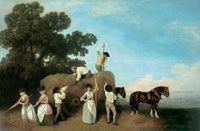 |
|
Haymakers, 1785
Oil on panel
Tate, London
Purchased with assistance from the Friends of the Tate Gallery, The Art Fund, the Pilgrim Trust, and subscribers 1977 |
When Stubbs was nearing sixty, he attempted to gain a broader audience by developing subjects depicting rural life. He ambitiously exhibited the Haymakers and its companion, the Reapers, at the Royal Academy of Arts in 1786. The paintings, acknowledged today as among Stubbs’s greatest masterpieces, met with a lukewarm reception. His critics found them lacking sentimentality and narrative detail.
As always, Stubbs strove to render convincingly the harmonious, dignified beauties of nature. The unforced actions of the haymakers are part of a gracefully orchestrated design that precisely incorporates each movement of raking and carting. The action pivots round the woman, who is posed at center like a classical goddess. She looks out, inviting the viewer to witness activities that, through ritualistic repetition, have become as intrinsic to nature as are the seasons.
 |
|
Reapers, 1785
Oil on panel
Tate, London
Purchased with assistance from the Friends of the Tate Gallery, The Art Fund, the Pilgrim Trust, and subscribers 1977 |
The Reapers and its companion, the Haymakers, were painted when nostalgic pastoral poetry celebrating the simple virtues of rural labor had become popular among city dwellers. Stubbs’s reapers gather and bind their sheaves in rhythmic repetitions evoking poetic cadences. He celebrates the bounty of nature and the labor of man with an idyllic vision.
Both the reapers and haymakers wear spotless finery and work effortlessly. Farming takes place under gentle, sunny skies, in pristine fields overburdened with grain. His vision is convincing because every detail is rendered accurately, from the method of binding sheaves, to the sparkle of a steel stirrup. Stubbs drew many preparatory life and on-site studies (now lost) to achieve pictures that could reveal nature both as it is and as it ideally might be.
 |
|
Otho, with John Larkin Up
1768
Oil on canvas
Tate, London
Presented by Paul Mellon through the British Sporting Art Trust 1979 |
Stubbs often portrayed thoroughbreds on their retirement from racing. These paintings commemorated the horses’ excellence and advertised them as breeders. Retired to stud in 1768, Otho possessed the straight legs and long, powerful neck desirable in thoroughbreds, though his racing career was undistinguished.
Stubbs depicts Otho at the Newmarket Heath racecourse, facing a rubbing-down shed. The town of Newmarket and Saint Mary’s Church appear in the background. The setting’s topographical specificity is characteristic of Stubbs’s mature paintings. John Larkin, a gentleman jockey who owned and rode racehorses, is shown dressed in dapper silks, seated on Otho with athletic, straight-backed ease. Both horse and rider look inward, perhaps contemplating their run — only Larkin knows it will be the last.
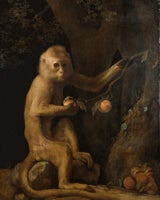 |
|
A Monkey,
1799
Oil on panel
Walker Art Gallery, National Museums Liverpool
|
Stubbs practiced naturalism with such compelling truthfulness that his critics claimed that his apparently realistic paintings demanded little creativity. To defend the artistry inherent in illusionism, Stubbs exhibited the first version of A Monkey at his Royal Academy debut in 1775.
Stubbs took as his theme the ancient origin of art as “the ape of nature.” In a primeval forest, where morning glories open at dawn, a monkey presents the viewer with a peach. If the viewer accepts this luscious gift, then he has been “peached,” or betrayed by his eyes. Stubbs’s Monkey is not real, it is an artistic illusion, as are all paintings. Modern scholars still dispute the exact type of monkey he depicted. Could it be that this ape of nature is also an entirely convincing deception by Stubbs?
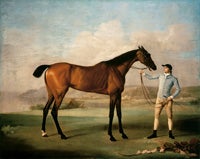 |
|
Molly Longlegs,
1762
Oil on canvas
Walker Art Gallery, National Museums Liverpool
|
The bay filly Molly Longlegs was retired from racing in 1762, the year Stubbs exhibited this painting in London. In this early work, Stubbs animates the conventional thoroughbred portrait by vividly capturing the horse’s individual character and circumstances. His immaculate brushwork renders the polished texture of Molly’s coat and the liquid spark of her rolling eye. She appears monumental against the expansive landscape, yet also vulnerable: a nervous, powerful creature stilled by intelligent trust in her jockey’s steady hand. The saddle, striped girth, and hood used for her exercise lie at the jockey’s feet.
Stubbs was preparing his publication The Anatomy of the Horse (1766) when he painted Molly Longlegs, and he emphasizes his anatomical mastery through attention to every detail of the filly’s skeletal structure and sinewy musculature.
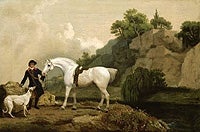 |
|
A Grey Hunter with a Groom and a Greyhound at Creswell Crags
c. 1766
Oil on canvas
Tate, London
Purchased 1895 |
Saddled for the hunt, the horse awaits his master. The horse is an English hunter, bred to possess the agile muscular build required for pursuing game over rough terrain. He looks down at a greyhound, the breed of dog used to course hares. Horse and hound prick forward their ears and sniff each other, joining as alert companions for the coming chase. The groom, his tasks complete, waits with exaggerated nonchalance.
Stubbs places the scene in Creswell Crags, a wild, rocky landscape in Nottinghamshire that he often used as the background for his dramatic horse and lion subjects. He employs the flowing, billowing clouds to counterbalance the tightly bound tension of the waiting hound and hunter.
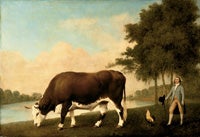 |
|
The Lincolnshire Ox,
1790
Oil on panel
Walker Art Gallery, National Museums Liverpool |
Stubbs often painted extraordinary animals such as the Lincolnshire ox, a giant creature that reportedly stood over six feet tall and weighed three thousand pounds. John Gibbons won the ox in a cockfight and in 1790 brought the prodigious beast and victorious bird to London for a spectacularly successful public exhibition. He commissioned this painting as a model for subscription prints. Stubbs imaginatively portrays the proud owner and his charges strolling in Saint James’s Park, each splendid male presenting himself to best advantage. The friezelike composition, which encourages comparison between animals and man, reflects Stubbs’s growing interest in comparative anatomy.
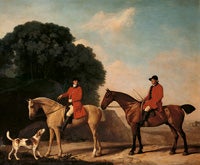 |
|
Thomas Smith, Huntsman of the Brocklesby Hounds, and His Father, Thomas Smith, Former Huntsman, with the Hound Wonder, 1776
Oil on panel
Private collection |
The first Earl of Yarborough’s foxhounds were among the best in England. Their success was due to the Smith family, who cared for the pack and trained it in huntsmanship for four generations. Stubbs underscores the hereditary status of the Huntsman of the Brocklesby Hounds by depicting the retired elder Smith, dignified and relaxed in the saddle, as he follows the lead of his son. The elder Smith’s grandson, William, recorded that his grandfather habitually warmed his hand in his pocket when he rode on chilly mornings. Stubbs used such accurately observed details to set his scenes and to impart psychological resonance to his portraits. Here both men “ride to covert,” searching for foxes. The hound Wonder raises his head, anticipating his new master’s signal to begin.
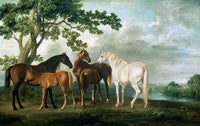 |
|
Mares and Foals in a River Landscape, c. 1763–65
Oil on canvas
Tate, London
Purchased with assistance from the Pilgrim Trust 1959 |
The thoroughbred racehorse, a cross between native British hunters and imported Arabian horses, was first bred in England in the early eighteenth century. To record the breed’s development, Stubbs originated this popular composition, showing mares nursing thoroughbred foals. The Viscount Midleton, who did not own racehorses, probably commissioned this painting in response to the beauty of Stubbs’s invention. The lone, brilliant white horse is set before drifting clouds and a shimmering, sinuous river. The tree’s strong curved boughs echo the sheltering silhouettes of the nursing bay mares. Stubbs’s imaginary scene proclaims his inventive skills as a painter of heroic animals and landscapes.
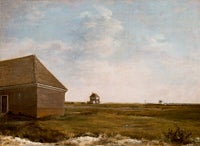 |
|
Newmarket Heath with a Rubbing-Down House, c. 1765
Oil on canvas
Tate, London
Purchased 1979 |
This hauntingly empty view of the racecourse at Newmarket Heath is one of two surviving pictures by Stubbs devoid of animal or man. It shows one of the four sheds in which the exhausted, sweating horses were rubbed down with straw or rags after they had finished exercising and racing. Newmarket was noisy and thronged with boisterous crowds from all walks of life. Stubbs, however, chose to depict the racecourse’s eerie, anticipatory quiet. Stubbs probably based this work on drawings he made on site and used it as a reference for his finished paintings.
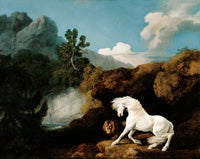 |
|
A Horse Frightened by a Lion, 1770
Oil on canvas
Walker Art Gallery, National Museums Liverpool |
Stubbs’s horse and lion paintings were responses to Edmund Burke’s popular concept of the Sublime: the thrill engendered by violent subjects that were awesome in their terrible beauty. When it showed terror, the horse — powerful, beautiful, and noble as man himself — exemplified the Sublime. The horse’s shock at encountering the lion reflected the viewer’s own.
In later paintings, Stubbs replaced the chestnut stallion with a white horse to emphasize the theme of struggle between good and evil. To lend the scene credence, Stubbs studied the white Hanoverian steeds in the royal stables, pushing a broom at them to record their backward, rearing motion. Horace Walpole praised such pictures for their transcendent verism: “Thy pencil, Stubbs, no rival need to fear; Not mimic art, but life itself is here.”
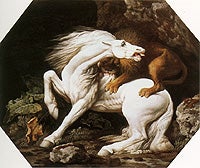 |
|
Horse Devoured by a Lion
1769
Enamel on copper
Tate, London
Purchased with assistance from the Friends of the Tate Gallery 1970 |
Stubbs spent years studying the chemistry of pigments in order to invent a formula for painting on copper, and this is his first work in that medium. Copper enamels were necessarily small, but were durable enough to be admired as paintings that were akin to ancient sculpture in their permanence. Stubbs received an astonishing one hundred guineas for this painting, and critics compared it to a classical cameo. Like the carvings on ancient gems, Stubbs’s figures dominate a composition based on the pristinely circumscribed interplay between light and dark. He masterfully juxtaposes the immaculate beauty of his painting technique with the brutal horror of his subject and achieves an effect at once aesthetic and visceral.
 |
|
Horse Attacked by a Lion
1763
Oil on canvas
Tate, London
Purchased 1976 |
The lion attacking a horse was the most popular of Stubbs’s imaginary subjects. He returned to it throughout his life, varying the moments of encounter and battle. The figure group was based on a famous classical marble sculpture that Stubbs saw during his youthful sojourn in Rome, and which Renaissance artists reproduced in bronzes later collected by English Grand Tourists. Stubbs drew the setting from his studies of Creswell Crags, a rocky, unpopulated landscape in Nottinghamshire.
In Stubbs’s time, the horse was regarded as a noble creature, closest to man in physical perfection and sensibility. The lion symbolized the primeval forces of unbound, often brutal nature. Stubbs’s series unusually presents a moral theme: it is the struggle, not the inevitable defeat that matters. Because he fights to the end, the noble, unyielding horse ultimately prevails.
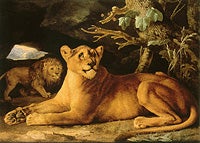 |
|
Lion and Lioness
1778
Fired enamel on Wedgwood earthenware
Courtesy of Simon C. Dickinson Ltd.
|
Stubbs daringly worked with few colors, exploiting instead the precision of finish unique to fired enamel on earthenware. Using tawny gold, seemingly bathed in light, Stubbs captures the textures of the lioness’s fur, the sharpness of her bristled whiskers, and the pellucid reflections in her eyes. The lioness relaxes with forepaws open but haunches tensed, curious to investigate what she and her mate observe. Stubbs’s image probably recalls how predatory cats responded to him as he studied them in menageries.
To create paintings that retained their brilliant colors and were as permanent as sculpture, Stubbs experimented with small enamels on copper (as in this example Horse Devoured by a Lion). To achieve even larger paintings Stubbs partnered with the ceramics manufacturer Josiah Wedgwood. This beautifully preserved, early example illustrates the success of their collaboration.
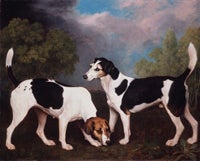 |
|
A Couple of Foxhounds, 1792
Oil on canvas
Tate, London
Purchased with assistance from the Friends of the Tate Gallery 1973 |
Late in his career, Stubbs simplified his compositions, combining monumental forms with his habitual, meticulous detail. Here a breeding pair of foxhounds dominates the canvas. Because they are depicted life-size, their vivid effect is startling. The Rev. Thomas Vyner, an avid sportsman, commissioned this picture. An anonymous family history records that Vyner was “a first rate judge of breeding hounds and everything connected with their management in the kennel and in the field.” Stubbs’s portrait must have commemorated a pair of hounds cherished by Vyner, and, like so many of his paintings, it is a work of memorable presence and quality.
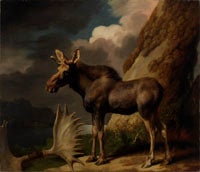 |
|
The Duke of Richmond’s First Bull Moose, 1770
Oil on canvas
Hunterian Museum and Art Gallery, University of Glasgow |
Eighteenth-century English noblemen imported North American moose to their estates for domestication and breeding. Their experiments failed, but these primitive-looking creatures remained of interest to natural scientists like William Hunter. Hunter studied Richmond’s yearling moose, and having stated, “Good paintings of animals give much clearer ideas than descriptions,” he commissioned Stubbs to paint an “exact resemblance” that included a pair of mature antlers.
Hunter intended to lecture at the Royal Society on his radical theory of natural extinction while displaying this work. Stubbs painted from direct observation, successfully completing his task with a scientist’s detached accuracy. Because the native habitat was unknown to him, Stubbs improbably depicted the moose commanding a mountain landscape. However, he did include a pond, as Hunter had recorded that moose ate “the rank herbage of marshy grounds.”
Major funding for George Stubbs (1724–1806): A Celebration has been provided by The Peter Jay Sharp Foundation. Corporate support has been provided by Fiduciary Trust Company International. Generous support has also been provided by Francis Finlay, Melvin R. Seiden in honor of Colin B. Bailey, and by the Fellows of The Frick Collection.
This exhibition is supported by an indemnity from the Federal Council on the Arts and Humanities.
|


